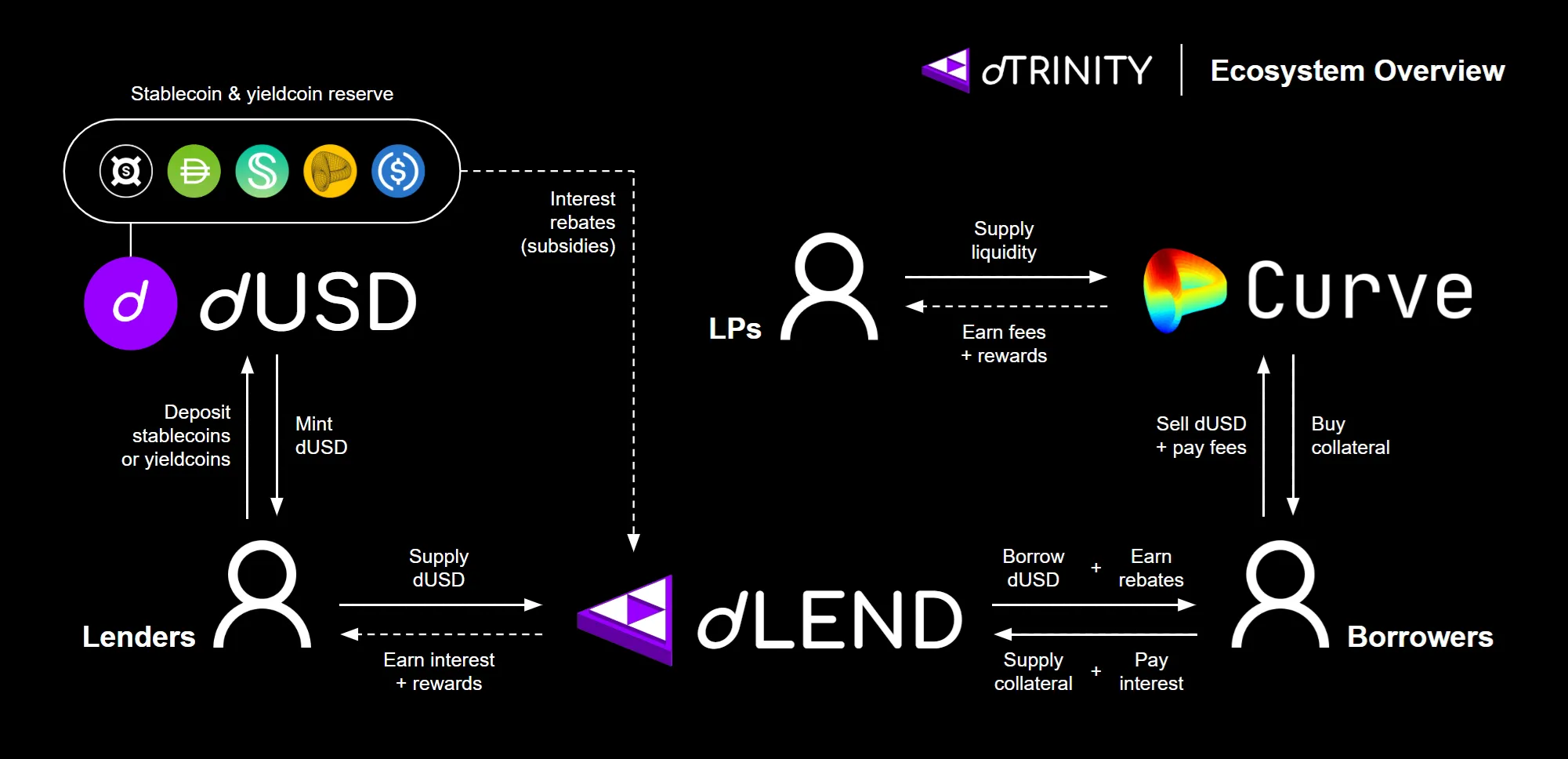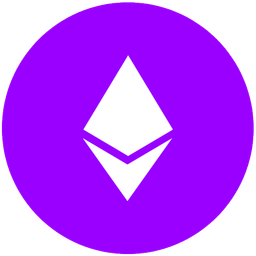Overview
Introducing the world’s first subsidized stablecoin protocol, designed to lower borrowing costs and enhance yields for stablecoin users.
dTRINITY first debuted on Fraxtal L2 in December 2024. The protocol has also been live on Sonic chain since May 2025 and Katana in October 2025, with follow-on expansions to Ethereum and other networks coming soon.
As the name implies, dTRINITY consists of three key DeFi primitives:
- Decentralized stablecoins fully backed by exogenous, yield-bearing reserves
- Decentralized lending protocols that offer subsidized stablecoin loans
- DEX liquidity pools for protocol-issued stablecoins
Additionally, tradable vaults for automated lending and looping strategies will be released to further simplify user experience, optimize yields, and enable composability for advanced integrations with other DeFi protocols.
By the end of 2025, a utility token will be launched to empower the dTRINITY community with governance rights over the protocol. Until then, users who supply liquidity for dTRINITY’s assets are rewarded with loyalty points that can be claimed for tokens upon the TGE (token generation event).
Core Components

1. Decentralized Stablecoins
 dUSD is a USD-pegged stablecoin, fully backed by USD-denominated stablecoins and yieldcoins. Similarly,
dUSD is a USD-pegged stablecoin, fully backed by USD-denominated stablecoins and yieldcoins. Similarly,  dS is a stablecoin pegged to Sonic (S), fully backed by S and S-based LSTs. In the future, dTRINITY will expand this model by launching
dS is a stablecoin pegged to Sonic (S), fully backed by S and S-based LSTs. In the future, dTRINITY will expand this model by launching  dETH (pegged to ETH) and
dETH (pegged to ETH) and  dBTC (pegged to BTC). These decentralized stablecoins—collectively referred to as “dSTABLE”—act as native units of account for the protocol. They are the first core component of dTRINITY’s ecosystem.
dBTC (pegged to BTC). These decentralized stablecoins—collectively referred to as “dSTABLE”—act as native units of account for the protocol. They are the first core component of dTRINITY’s ecosystem.dSTABLE assets are demand-centric, meaning they don't distribute the underlying yields to supply-side users (i.e., token holders/stakers). Instead, each dSTABLE’s reserve earnings are used to fund ongoing interest rebates for its borrowers on dLEND and partnered lending protocols.
Every dSTABLE asset is backed 1:1 by non-custodial reserves. Users can mint tokens permissionlessly by depositing whitelisted reserve assets. Redemption is currently under development and will be released in Q2 ‘25. In the mean time, users can sell dSTABLE assets on DEXs if they wish to exit. The protocol may also use underlying reserves to repurchase and redeem dSTABLE assets via open market operations to optimize stability and liquidity on DEXs.
2. Decentralized Exchanges
 DEX Pools like those on Curve and Beets form the liquidity layer for dSTABLE assets. They are the second core component of the dTRINITY ecosystem.
DEX Pools like those on Curve and Beets form the liquidity layer for dSTABLE assets. They are the second core component of the dTRINITY ecosystem. Liquidity pools are vital in facilitating low-slippage swaps and liquidations between stablecoins and other assets. Liquidity providers (LPs) can also earn ecosystem rewards and/or swap fees by depositing assets in these pools. dSTABLE LPs, in particular, may earn better fees thanks to subsidy-driven trading volume and credit velocity.
In addition to Curve and Beets, other DEX integrations will be rolled out over time to strengthen on-chain liquidity and unlock more yield opportunities for dSTABLE assets.
3. Lending Protocols
 dLEND is dTRINITY's native lending protocol, powered by subsidized dSTABLE markets. dTRINITY will also collaborate with external DeFi Partners like Silo and Fraxlend to export its subsidy model beyond dLEND. Together, these money markets form the credit layer for dSTABLE assets—the final core component of dTRINITY’s ecosystem.
dLEND is dTRINITY's native lending protocol, powered by subsidized dSTABLE markets. dTRINITY will also collaborate with external DeFi Partners like Silo and Fraxlend to export its subsidy model beyond dLEND. Together, these money markets form the credit layer for dSTABLE assets—the final core component of dTRINITY’s ecosystem.Users who supply dSTABLE assets in money markets can earn Yields & Rewards from ecosystem partners and/or the protocol. Borrowers can then supply multiple collaterals to borrow dSTABLE assets and earn interest rebates. This could give them access to below-market borrowing rates, providing cheap credit to amplify leverage and yield-looping strategies.
Subsidized borrowing demand also drives protocol utilization to above-average levels, which pushes dSTABLE Supply APYs above market rates—delivering better yields to lenders while minimizing their opportunity costs.

Blessed are the borrowers in debt, for theirs is the kingdom of leverage.
Blessed are the lenders, for they will inherit the yield.
Blessed are those who hunger and thirst for liquidity, for they will be filled.
Other Components
Utility Token & Points
 TRIN is the future utility and governance token of dTRINITY. Prior to the TGE, lenders, LPs, and community members are rewarded with “dT Points” through the
TRIN is the future utility and governance token of dTRINITY. Prior to the TGE, lenders, LPs, and community members are rewarded with “dT Points” through the  Points Program for their ecosystem contribution. During the TGE, all accrued points will be converted to TRIN.
Points Program for their ecosystem contribution. During the TGE, all accrued points will be converted to TRIN.Staking Vaults
dSTAKE is a series of ERC-4626 vaults that let users stake dSTABLE assets, which are then supplied automatically to money markets on dLEND and partnered lending protocols. These vaults are expected to generate above-market yields thanks to subsidy-driven utilization. They also earn points and other rewards on top of lending yields.
Through tradable receipt tokens, dSTAKE vaults enable composability for lending deposits by creating liquid, yield-bearing versions of dSTABLE assets. Users can then supply these vault tokens in other protocols to access even more utilities and opportunities (e.g., DEXs, lending protocols, interest rate marketplaces).
Looping Vaults
Loopcoins are akin to leveraged ETFs in TradFi. They are designed to simplify the looping process through a one-click user experience. dLOOP vault tokens can be supplied in other protocols to unlock more utilities and opportunities as well.
For instructions on how to borrow, lend, loop, and LP, please refer to our User Guide.
